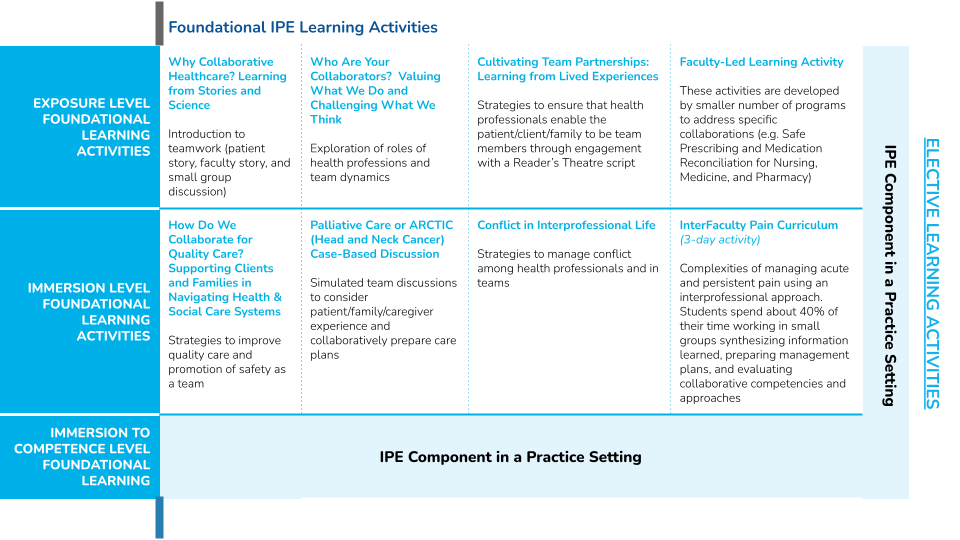Main Second Level Navigation
Breadcrumbs
- Home
- Curriculum
- Curriculum
- IPE Foundational Learning Activities
IPE Foundational Learning Activities
Foundational Curricular Learning Activities

Why Collaborative Healthcare? Learning from stories and science
This introductory learning activity powerfully brings together the entire incoming cohort of health science students. Students will leave this session inspired to grow as collaborative and team-based healthcare providers, through the Interprofessional Education (IPE) Curriculum and other experiences. Students will leave this session with a new or reinforced appreciation for the experiential ways in which collaboration can enhance care.
Who are your collaborators? Valuing what we do and challenging what we think
Students gather in collaborative teams to collaboratively explore perspectives on the roles and scopes of practice of their own and other health and social care professions. Student teams will engage in small group discussions and activities to consider how to negotiate roles and navigate role overlap in practice. Through critical reflection on biases and stereotypes associated with roles, students will be encouraged to be curious about and value the knowledge that every team member brings to optimize care.
Cultivating Team Partnerships: Learning from Lived Experiences
Students will explore partnerships with patient/client/family/caregiver in a team context by learning from experiences of patient/client/family/caregiver partners and through engaging in a verbatim Reader’s Theatre script on partnership developed by University of Toronto students and faculty. Student groups will have the opportunity to work with a patient partner and facilitator to discuss and analyze concepts related to patient/client partnerships through discussion questions provided.
Faculty-Led Learning Activity
This time is protected for two or more programs to collaborate to create a relevant Exposure Level interprofessional learning activity for their students. The topic of this learning activity is developed by interested programs to enhance learning that is relevant to a smaller group of disciplines. The learning objectives and curriculum outline are set by the participating programs.
How Do We Collaborate for Quality Care? Supporting Clients and Families in Navigating Health & Social Care Systems
This activity is designed to immerse learners in collaborative leadership, interprofessional quality improvement, and safety practices through interactive, interprofessional small group learning using a client and family case study.
Conflict in Interprofessional Life
Conflict in Interprofessional Life is designed to reinforce that conflict is a natural part of our working life and influences our ability to make good decisions. Although conflict can be expected in the workplace, we have a professional responsibility to learn to engage conflict effectively, and with composure. An individual’s ability to manage conflict affects how an interprofessional team will function.
Case-based Learning Activity: Pain Curriculum, Palliative Care and/or ARCTIC
The educational context for Palliative Care is a simulated “interprofessional team meeting” during which each learner represents their respective profession. By participating in and contributing in this interprofessional team meeting, students learn about palliative care and requirements of "patient/client/family meeting" involving a patient/client with advanced disease.
ARCTIC: Appreciating Roles and Collaboration to Improve Care: Head and Neck Cancer is a case-based learning activity developed by Sunnybrook Health Sciences Centre. As a large group, students view a head and neck oncology patient’s narrative and debrief about the experience. Students participate in small interprofessional teams discussions to define their role in head and neck oncology and develop a team care plan.
IPE Component in a Practice Setting
This learning activity is built into existing clinical placements at one or more practice sites, and focuses on the development of competence in interprofessional collaboration. Students are integrated into care settings where they interact and work with patients/clients and other interprofessional team members. The IPE Component in a Practice Setting can be delivered in a structured or flexible model to be completed over the course of the student’s educational program with our many practice partners:
IPE Structured Placement
Students are placed in an interprofessional team within a clinical care unit at a practice site. They participate in one or two facilitated introductory tutorials and then continue to meet as a group on a regular basis for patient/client/family-themed tutorials. Upon completion of their clinical experience, they deliver a group presentation.
IPE Flexible Placement
Students who are not able to participate in a structured IPE placement will need to work with their placement supervisor to complete the following 3 IPE Flexible Activities:
Flexible Activity 1 - Shadowing and/or Interviewing Team Members
Through shadowing and/or interviewing, learners will have the opportunity to learn about, from and with a team member (ie a staff member or provider) from another profession and/or role, as well as learn with the patient/client/family as part of the team. This activity could be completed at any point, but is most appropriate for learners in early placements.
Flexible Activity 2 - Analyzing Interprofessional Interactions of Team Members
Successful interprofessional team interactions are based on communication, shared decision-making, respect and shared leadership. Through observing and/or participating in interprofessional team interactions, learners have the opportunity to analyze the nature of the interactions as well as the impact on their patients/clients/family. This activity could be completed at any point but is most appropriate for learners in intermediate to senior level placements.
Flexible Activity 3 - Collaborating with Team Members
In this activity, learners engage in a collaborative activity with one or more team members or learner(s) from another profession/role, and reflect on the factors that enabled or hindered the collaboration. This activity could focus on an interdependent task that occurs as part of assigned responsibilities while on placement or could be arranged with preceptors/supervisors. This activity could be completed at any point but is most appropriate for learners in senior level placements who have a stronger understanding of their professional contributions and are able to work with greater independence.
- Please see curriculum tools and resources for the downloadable pdf forms for the flexible activities.
- Flexible Activity Sheet - can be a helpful resource for Supervisors and Staff!